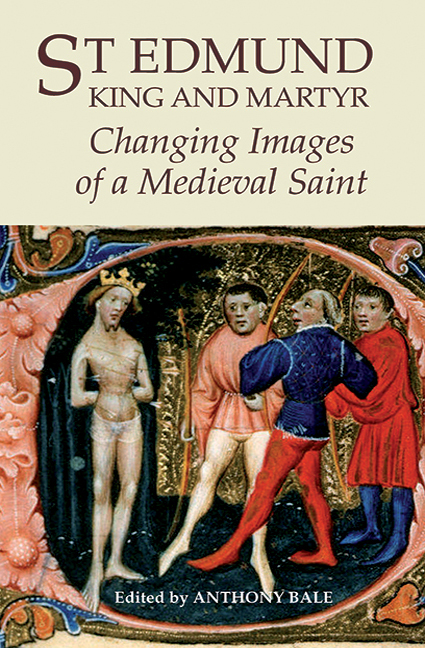Book contents
- Frontmatter
- Contents
- Preface
- List of Contributors
- List of Abbreviations
- Introduction: St Edmund's Medieval Lives
- 1 King, Martyr and Virgin: Imitatio Christi in Ælfric's Life of St Edmund
- 2 Chronology, Genealogy and Conversion: The Afterlife of St Edmund in the North
- 3 Geoffrey of Wells’ Liber de infantia sancti Edmundi and the ‘Anarchy’ of King Stephen's Reign
- 4 Music and Identity in Medieval Bury St Edmunds
- 5 Medieval images of St Edmund in Norfolk Churches
- 6 John Lydgate's Lives of Ss Edmund and Fremund: Politics, Hagiography and Literature
- 7 St Edmund in Fifteenth-Century London: The Lydgatian Miracles of St Edmund
- 8 The Later Lives of St Edmund: John Lydgate to John Stow
- Select Bibliography
- Index
- Miscellaneous Endmatter
8 - The Later Lives of St Edmund: John Lydgate to John Stow
Published online by Cambridge University Press: 11 May 2017
- Frontmatter
- Contents
- Preface
- List of Contributors
- List of Abbreviations
- Introduction: St Edmund's Medieval Lives
- 1 King, Martyr and Virgin: Imitatio Christi in Ælfric's Life of St Edmund
- 2 Chronology, Genealogy and Conversion: The Afterlife of St Edmund in the North
- 3 Geoffrey of Wells’ Liber de infantia sancti Edmundi and the ‘Anarchy’ of King Stephen's Reign
- 4 Music and Identity in Medieval Bury St Edmunds
- 5 Medieval images of St Edmund in Norfolk Churches
- 6 John Lydgate's Lives of Ss Edmund and Fremund: Politics, Hagiography and Literature
- 7 St Edmund in Fifteenth-Century London: The Lydgatian Miracles of St Edmund
- 8 The Later Lives of St Edmund: John Lydgate to John Stow
- Select Bibliography
- Index
- Miscellaneous Endmatter
Summary
In 1538, some of Thomas Cromwell's agents at the time of the dissolution of the English monasteries reported by letter to their employer that they had
been at St Edmund's Bury, where we found a rich shrine very cumbrous to deface. Have taken in the monastery over 5,000 mks. in gold and silver besides a rich cross with emeralds and stones of great value; yet have left the church, abbot and convent well furnished with silver plate.
Another of Cromwell's men, the zealous reformer John Ap Rice (or Prise), had already had a great deal to say to Cromwell about the monastery at Bury, whose visitations he oversaw in 1535 and 1536. The abbot, he wrote, ‘delited moche in playing at dice and cards’; the monks had a great ‘frequence of women’. He complained of the dull silences of the monks; he was sure that ‘they had confedered and compacted before our coming that they shulde disclose nothing’ on the matter of the abuses in the community, whose basis was no longer a fraternal ideal – a fellowship in Christ – but precisely the ill-contrived pretence he so abhorred. The monks and the monastery they inhabited, like the shrine itself, concealed nothing of true value, only forms of bodily corruption: ‘the coles that St Laurence was toasted withal, the paring of St Edmundes naylles, St Thomas of Canterbury penneknyff and his bootes and divers skulls for the headache, pieces of the Holy Cross able to make a whole cross of, other relics for rain’. The foundation at Bury, it seems, really had the Reformation coming to it. But it would have lessened the honour of Ap Rice's triumph rather sadly if the ancient establishment had yielded all that it valued on some of its own silver platters. The reformers made no such claim. The task that they undertook was a challenging one, for the confection of stones and metal heaped upon Edmund's dead body, like the brethren's confederacy, was ‘very cumbrous’ – the medieval past thick and stubborn, and almost immovable.
- Type
- Chapter
- Information
- St Edmund, King and MartyrChanging Images of a Medieval Saint, pp. 163 - 186Publisher: Boydell & BrewerPrint publication year: 2009

